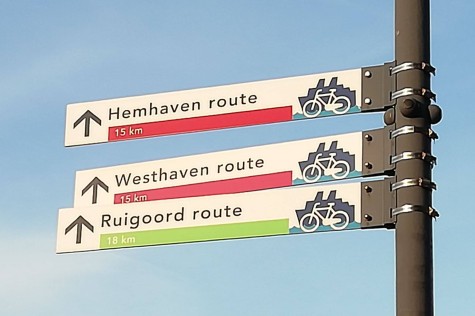Westhaven route
You cycle along the tangible evidence of the new direction the port is taking: that of the circular economy. We're still developing in this respect. That is why you'll also come across large storage tanks for petrol along the way.
Practical information
- Length: 15 km
- Starting point: Amsterdam Sloterdijk station
- Route: follow the signs from the cycle path at Orlyplein
- End point: Amsterdam Sloterdijk station

What you'll see along the way
Prefer a shorter or longer route?
Stadhaven route
Length: 5 km
Highlights: mix of shipping, business and city life
Hemhaven route
Length: 15 km
Highlights: mountains of bulk goods, shore swallows, peregrine falcons
Ruigoord route
Length: 18 km
Highlights: artist village Ruigoord, centuries-old duck decoy
Biogas
Here you are in the middle of the new circular economy. This is where we bring together companies that use each other's waste and residual streams to create something new. Here, for example, old deep-frying fat turns into biodiesel. And VGF waste into biogas.
The result is an economy in which companies form cycles with each other, in which residues are reused again and again and do not end up on a waste heap. That is where we want to go in the port. That is why you will find AEB Amsterdam, NOBA, Rotie, Orgaworld and Biodiesel Amsterdam together here. All companies that process waste into energy.
And that's necessary too, because more and more residents, visitors and companies are joining in. That also means more housing, traffic and energy - and more waste. That is a challenge, but we see it as an opportunity. Because where do all these streams come together? Here, in the port. If we connect these chains, we will soon have no more waste and always enough raw materials.
All Weather Terminal
The All Weather Terminal of VCK Logistics turns the Amsterdam port into a kind of 5-star accommodation for goods. The halls of this terminal have a climate control system that can be adjusted in such a way that all kinds of goods remain there in optimal condition.
A load of paper, for example, cannot have too humid conditions because of the risk of mould. This is why the humidity in these halls can be reduced. This is also important for steel, because otherwise it will rust. And substances that expand at a higher temperature can remain cool here.
The All Weather Terminal was the first in the world in 1998. It turned out to be such a success that since then several All Weather Terminals can be found in the port of Amsterdam and that many other world ports have followed suit.
Cocoa port
The video is in Dutch.
Wind near and far
The video is in Dutch.
Helophyte filter
A helophyte filter is a water purification system that works with plants. Helophyte is the botanical name for marsh plants. These plants have the convenient feature of attracting bacteria around their roots that purify contaminants from the water. If you make a pond from such marsh plants and you feed water through it, then you have a natural water filter.
We use such filters at various places in the harbour area, to purify rainwater that drains away from the industrial estates. By purifying it in this way, it doesn't have to enter the sewer and we can discharge it into the surface water. In this way we put less strain on the sewer.
These helophyte filters contain reed, cattail, rushes and yellow and blue irises. In the reed you will find birds such as the reed warbler, the reed bunting, the putter, the chiffchaff and the greenfinch. Many insect species also live here. And the natterjack toad can take a dip in the water here.
De Koperen Ploeg
Sounds tough, doesn't it, "The Copper Plough"? The history of this 'Boat and Steersman's Cooperative' goes back to 1876. That's when the North Sea Canal was opened, and several companies came into being that helped large ships moor in the harbour. In 1926 these companies were merged into De Koperen Ploeg.
De Koperen Ploeg is still specialized in the mooring and unmooring of seagoing vessels. When a ship enters the port, the skippers of De Koperen Ploeg take over the helm. These specialists know down to the last centimetre how the enormous ships have to sail through the port without hitting anything.
Furthermore, De Koperen Ploeg ensures that the ship remains safely moored, with protection between the ship and the shore. De Koperen Ploeg also takes care of the customs clearance for the ships.
Vosse Groen Recycling
Trees that are felled, grass that is mowed or branches that have been pruned: if you put it together on a heap and wait a while, then you have compost. And that's a wonderful enrichment for every garden, farmland and park.
Vosse Groen Recycling collects green waste and turns it into top quality compost. It could just be that the park in your neighbourhood is so green thanks to compost from this company. Private individuals are also welcome to buy compost here. This way you have a top quality soil enricher from your own neighbourhood. Good for the garden, but also for plants in pots.
And that's not the only thing Vosse Groen Recycling does with its green waste. Wood chips can also serve as biomass from which energy is made. The company therefore supplies green waste to power plants that use it to generate electricity.
Granuband
This is another example of the new circular economy. Granular tyre grinds old car tyres into granules. These are grains that in turn form the basis for new products. Granuband, for example, turns them into playground tiles and terrace tiles, and material for plastic football pitches.
The company also provides advice, machines and assistance to companies that want to do the same. And so there is less and less waste in the world.
Paro
We build, rebuild and demolish something in the Netherlands. This involves a lot of waste, and Paro specialises in transporting and processing that construction waste. Here too, as much material as possible goes on to other companies, who can use it for something useful. For example, wood goes to energy-from-waste plants that burn it, which in turn generates energy and heat.
Paro itself also produces building materials from construction waste. All kinds of installations on the Paro site sort, crush, sieve and/or wash the waste so that it is suitable for road construction and the concrete and cement industry, for example.
Puddle of toads
The video is in Dutch.
Petrol
It is true that we are busy with the energy transition by, among other things, enabling the generation of renewable energy in the port area. But petrol is still being transported, stored and processed. The Amsterdam port is even the largest petrol port in the world.
The various terminals in this part of the port contain all kinds of oil products, to be mixed and processed into petrol and kerosene for example (with a pipeline to Schiphol). Various companies sit here together to make use of each other's products in this area.
Koopman Car Terminal
This company arranges the transport and storage of cars for manufacturers and leasing companies. Koopman also prepares cars for sale for lease companies. On Koopman's premises, everything is in place to make a lease car tip-top again - there is even a high-tech photo studio.
Monumentenwerf
Monumentenwerf Amsterdam processes building materials from monumental buildings and paving. Facade ornaments, doors, bricks, roof tiles - often beautiful materials that it would be a shame to throw away.
Monumentenwerf Amsterdam refurbishes these historical building materials so that they can be used again when renovating other monuments. Unfortunately, as a private individual you can't go here for your antique floor tiles, but your contractor can.
ADM site
This used to be the Amsterdamse Droogdok Maatschappij (ADM), founded in 1877. This shipyard repaired and rebuilt ships, and also built new ships. In 1985 the company went bankrupt. After that, the site was squatted for years. The 130 artists who lived there for more than 20 years changed the name to the Amsterdam Do-it-yourself Company.
In 2019, this part of the port regained its original port destination, including a shipyard.
